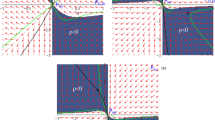Abstract
Recently a homogeneous cosmological model free from singularities was proposed, based on the general relativity theory. It described a closed universe (k = +1), initially filled with prematter, characterized by a density ρ equal to the Planck density and a pressureP = −ρ, and undergoing oscillations. In the present work the case of a similar, but spatially flat, universe (k = 0) is investigated. In this case there is an initial geometric singularity (the scale factorR = 0), but not a physical one, since the initial density is finite. This universe begins its existence at a timet = −∞ and, after going through the prematter and radiation-dominated eras, reaches the matter-dominated state and continues to expand indefinitely.
Similar content being viewed by others
References
Israelit, M. and Rosen, N.: 1989,Astroph. J. 342, 627.
Primack, J.R., Seckel, D. and Sadoulet, B.: 1988,Ann. Rev. Nucl. and Part. Sci. 38, 751.
Weinberg, S.: 1972,Gravitation and Cosmology, J. Wiley and Sons, New York.
Author information
Authors and Affiliations
Rights and permissions
About this article
Cite this article
Israelit, M., Rosen, N. A spatially-flat cosmological model. Astrophys Space Sci 204, 317–327 (1993). https://doi.org/10.1007/BF00658034
Received:
Issue Date:
DOI: https://doi.org/10.1007/BF00658034




